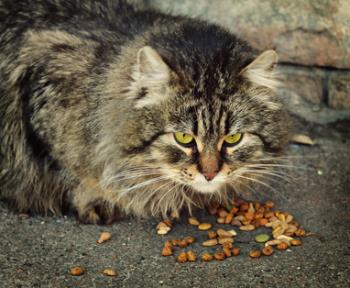The diagnosis of diabetes in veterinary medicine is widespread and climbing. It affects both cats and dogs: in the United States, one in 400 dogs and one in 150 cats are affected. Results are similar in the UK and Australia. Even more so, numbers are climbing and there is little doubt that the cause is our lifestyle, and the lifestyle we impose upon our pets.

In this article, we are going to ask why diabetes is so common in cats these days. Of course, we will talk a lot about human diabetes and a bit about dogs, too.
What is diabetes mellitus
Before that, however, you must understand what diabetes is and how it works. You should know that cats and dogs, as mammals, get the same diabetes as humans. Cats and dogs also get the same diabetes symptoms as humans. Devil is in the details, but generally, it is the same disease(s). This means that with a little precaution, we can apply findings in human medicine in the veterinary field, and vice verse. In fact, scientists often study cat diabetes to understand human one.
In short, diabetes is the body’s inability to regulate blood sugar levels adequately. When you eat something, your body breaks down sugar it contains and passes it into your bloodstream. Good, because you and your cat’s body needs sugar to operate.
The thing is that we only eat several times per day, but our body needs almost a constant stream of energy. To overcome this problem, our body stores part of the energy as glycogen. The hormone insulin regulates the process. If the body detects that sugar levels climb, it produces more insulin. Diabetes happens when something in this process goes wrong.
What could possibly go wrong? The most common disruptions are known as type-I and type-II diabetes, which essentially are two diseases:
- type-I diabetes: the body stops or reduces insulin production.
- type-II diabetes: the body becomes tolerant to insulin. That is, it needs more insulin for the same job.
The first one is uncommon in cats and is also less popular (than type-II) in humans. However, it is the most common type of diabetes in dogs. What causes diabetes in dogs? We don’t know. The mechanism of action includes the body’s immune system destroying its own insulin-producing cells. Why this happens isn’t clear. The disease is highly heritable, yet, more and more evidence suggests that our environment plays a role, as well.
What causes diabetes in cats
Among cats and humans, however, type-II diabetes is more common, and this type has a lot to do with our environment and things that we can influence.
Is diabetes on the rise because of something that we do or how we and our pets live? There is strong evidence that our life choices affect the risk of diabetes. For example, obesity, diet, activity levels, aging, gender, being neutered, and medicine we use. But there is also enough evidence to state that it’s not only that.
Is the risk of diabetes caused by our genes?
To state that disease has genetic grounds, we need to look at whether it is more common in specific lineages or breeds. Burmese cats are at higher risk, which is similar to the fact that in humans, some ethnicities are more prone to diabetes, unfortunately. This signifies that besides lifestyle, the risk for diabetes can be inherited.
Male cats are also more at risk. This also could mean that inheritance has a role in developing diabetes. Interestingly, the risk of diabetes in male cats is increased regardless of whether the cat is overweight or not.
We also know that people whose parents or siblings have diabetes are more likely to get it, too. Note: It isn’t diabetes that gets inherited; it is the increased risk to get it. This isn’t quite the same thing.
You still need the right conditions to develop diabetes, even if you inherit an increased risk of it. And speaking of which, it leads us to the number one risk factor for human and cat diabetes—extra weight.
Does obesity cause diabetes?
Obesity is by far the most dominant risk factor for type II diabetes in humans, and enough evidence is to claim that it is the same for cats.
Evidence shows that obesity as a risk factor for diabetes by far exceeds other factors. There is a study that stated that eating dry food is a risk factor for non-obese cats, but it isn’t for obese cats. This means that, if a cat is overweight, the effect of other risk factors are negligible.
Turns out, how much you eat is more important than what you eat. For example, rice is always a better choice than fried potatoes. However, not if you choose a single portion of fries and go double for rice. But that, of course, is not a realistic picture, because no one settles for a single portion of fries.
Thus, if there is a single choice for your pet’s health that matters the most—it’s keeping them fit. Not only because of diabetes, but becasue obesity is also a risk factor for many diseases.
How can obesity cause diabetes?
But what is so special about being fat and developing diabetes? Body fat isn’t just a lump of an oily substance; it is a tissue that secretes hormones and other substances of its own. You can easily imagine, when there is an increased amount of body fat, these hormones are also produced in excess.
The hypothesis is that some of these substances mess with insulin resistance. In other words, the body needs more insulin to achieve the same effect. Since this increased need for insulin is present 24/7, it results in almost constant extra load on pancreatic cells that produce it. No wonder they fail eventually.
The above mentioned, though, is an oversimplification. If you wish, check here for a more detailed explanation of how obesity causes diabetes.
Obesity, diet or sedentary lifestyle
What else besides obesity can influence diabetes risk for cats? Activity levels and diet can have their say, as well. However, it is a slippery statement. You can’t tell if the food and low activity itself lead to diabetes, or do they first lead to obesity and then to diabetes.
Just several years eating dry food is a risk factor that generated quite some news, with the central theme throughout reportings—dry food causes diabetes. The claim is a slight exaggeration and is not what scientists actually told. What they found is that healthy weighted cats on dry food had diabetes more often.

This sort of indicates that there might be a direct link between dry food and diabetes, but only might, and only sort of. In the published paper, scientists explicitly stated that their “results should be interpreted with caution” for numerous reasons. The most important one, according to the scientists, was the fact that the study was based on owner assessment.
People suck at assessing their cats’ physical condition realistically. We have clients whose pets are obviously overweight, but when we break them the news, they insist they had no clue about it.
In the context of the mentioned study, it could result that owners of diabetic cats are more likely to be aware that their pet is obese. Simply, because their vet told them upon diagnosis.
However, apart from that, there is sound logic behind the reasoning that dry food could increase diabetes risk. For once, they usually contain more carbohydrates than average wet food, and this might cause problems for a cat, who is a strict carnivore by nature. Additionally, carbohydrates temporarily increase blood sugar levels, which generates extra load on insulin selection.
At the same time, this is how the body functions normally. Besides, as logic as it sounds, and as much as news loved to support it by the mentioned study, one can not claim from it that dry food leads to diabetes.
But let’s not forget that dry food, because of it’s dense energy packing, is a risk factor for obesity. But that, our friends, is a matter of owners discipline: your cat eats only as much food, as you feed him. And he moves as much as you encourage him, making your pet’s obesity much under your influence.
And speaking of activity, it is also theorized that not only low activity leads to obesity, but low activity by itself could be a direct risk factor to insulin resistance and diabetes. How come?
Because, at least in humans, the difference between being fit or unfit, and not necessarily overweight, shows in the composition of muscle tissue. This change can play a role in insulin sensitivity, leading to people in a good physical form require less insulin to regulate their blood sugar. What does it mean?
It means that there are no shortcuts. Keep your cat active: learn here how to do it.
Health professionals have talked for decades that physical activity is among things that influence our health the most. There is no reason to think that cats are different.
Other risk factors of diabetes in cats
The above mentioned are major contributing factors for diabetes in both human and veterinary medicine. To recap, it is obesity and low activity (even if this low activity doesn’t lead to obesity). But there are several other ones.
Drugs used in veterinary medicine can mess with glucose levels and insulin secretion. In turn, it can increase the risk of diabetes if used for a prolonged time.
Common culprits are corticosteroids and progestins. First ones have a wide variety of usage, but doctors rarely prescribe them for long-term use. Progestins, on the other hand, are widely used for birth control and preventing intact female cats from coming in heat. They have a long list of possible complications, among which diabetes is not the scariest one.
Finally, it should also be said that old age is another risk factor for diabetes. While a young cat may get diabetes, most cats diagnosed are older than eight years.
Though on the surface, it may sound silly, old age could be an important reason why more and more cats get diabetes. Simply stating, thanks to advances in medicine and nutrition, household cats live longer. Long life, however, comes with a higher risk of diabetes. That is the reality of modern medicine, we may solve one disease, yet another one is lurking around the corner.
But no need to feel sad. In the process, living longer is good after-all, isn’t it? We are quite sure medicine will figure out how to cure or prevent diabetes, but it will take time.
In the meantime, it is clear that obesity is by far the most crucial risk factor for diabetes. Not only in cats, but in humans, as well. If there would be only one thigh you could do for your pet’s health—make your cat lose weight.
